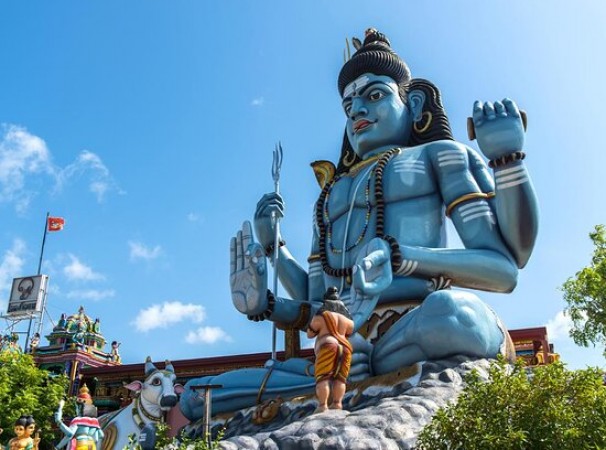KONESWARAM TEMPLE
The Holy Koneswaram Temple, is a Hindu temple in Trincomalee on the east coast of Sri Lanka. The temple lies on a high rocky promontory surrounded on three sides by the sea. It bears a history of over three millennia with its records indicating its roots in 1580 BC. This, still beautiful, historical monument is what remains of what once was a sprawling temple city equal to the ancient city of Madurai, India.
Koneswaram gains its name from the main deity of the temple, the Hindu God Shiva. Shiva, who is also called Eeshwar or Eeshwarar, reigns over the mountain of Holy Konam hence giving the name Thirukoneswaram. The name ‘Konam’ is believed to have come from the Old Tamil word meaning ‘peak’.
Another name given to the temple is ‘Dakshina Kailayam’; a Sanskrit name meaning ‘Mount Kailash of the South’. Some also call it ‘Aathi Koneswaram’, where ‘Aathi’ is the Tamil word for ancient.
The legend states that King Ravana, along with his mother, was a devout worshipper of Koneswaram. Ravana is also supposed to have created the hot springs of Kanniya as part of Thirukoneswaram, for the last rites of his mother. King Ravana was a legendary emperor of Sri Lanka who is believed to have lived over 5000 years ago. If this legend were to be true, then that would indicate that the temple was alive and thriving for over 5000 years.
Koneswaram was one of the five Eeshwarams that dominated the ancient landscape of Sri Lanka according to the 16th century Portuguese historian Diogo de Couto; along with Ketheeshwaram, Munneshwaram, Naguleshwaram and the now destroyed Tenavaram.The Indian exile and Sri Lankan royalty, Prince Vijayan, and his followers are also said to have renovated the temple on their arrival to the island; according to the 18th century Tamil historical chronicle, Yalpana Vaipava Malai.
The true rise of Koneswaram however occurred in 205 BC when the Chola king Elara Manu Needhi Cholan renovated the temple creating a temple complex that mirrored the Dravidian temple cities. The city was built as huge temple city with the Thirukoneswaram temple at its centre. The city was entered through gates that were housed in smaller temples, and the walls surrounded fields and various shrines in addition to the homes of occupants. The temple complex/city covered most of Trincomalee as it is now. The pilgrimage path was 225km long and was traditionally travelled by foot. There were separate shrines and temples for gods and goddesses like Ganesha, Padrakali, Vishnu/Thirumal, Shakthi, Suryan (Sun), Murukan and also King Ravana.
The main temple of Koneswaram was created, on the summit of the rocky promontory, with hard black granite (Karungal) which was skillfully carved with classical temple bas relief sculptures by Indian temple architects and sculptors. One of its finest features was its Thousand-Pillared hall which was used to host religious and cultural events. The hall was so famous that the Portuguese who visited temple called it the Temple of a Thousand Pillars.
The fame of Koneswaram continued to rise through the next millennium. The temple was one of only two non-Indian temples that were praised by the great 6th century AD Hindu poet-saint Sambandhar in his Tevarams, the other temple Thiruketheeshwaram also being in Sri Lanka. Records from the Kingdom of Anuradhapura in the 4th to 7th century AD and the Kingdom of Jaffna which rose between the 12th and 17th centuries AD; as well as records from the Chola, Pallava and Pandya Kingdoms of India show that kings from over a millennia both donated, contributed and made renovations for Koneswaram.
On entering the visitors are faced with the awe-striking sight of the ancient Svayambu Lingam, housed in the main shrine room or Moolasthanam (translation: centre point). The moolasthanam of Thirukoneswaram is slightly different in that unlike most moolasthanams it doesn’t have one shrine but two. To the left of the lingam (from the lingam’s view) facing towards the side entrance, is the shrine room of Koneswarar’s consort Goddess Mathumai Ammal. Both shrines are in a larger room which combined is the moolasthanam.
The roof and insides of the temple are beautifully sculpted and painted colourfully. The pillar to the right after entering has a large image depicting all the shrines in the temple, and the order of worshipping them. In a nut shell the order is always in a clockwise rotation. One, three or five rotations may be made depending on the ease of the devotee. The same applies to each individual shrine as well, except the main shrine as it lies in the centre.
The wall to the left just after entering bears a beautifully painted image of the temple as it appeared originally before its destruction 400 years ago. The painting is so well done it appears three dimensional such that it takes effort to realise that it’s not a bas relief.
Day Tours
See more
See less
Round Tours
See more
See less
Things To Do
See more
See less

